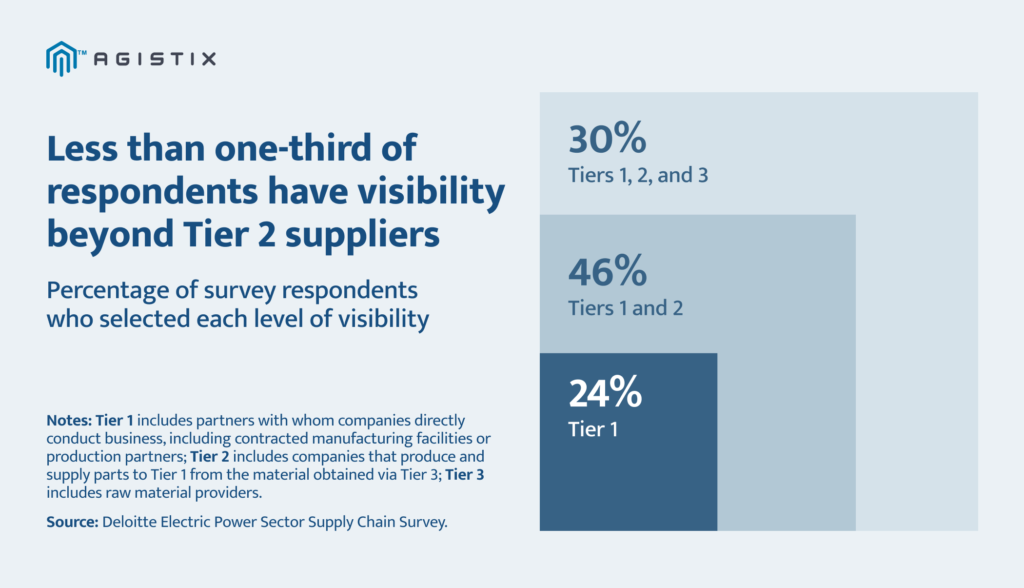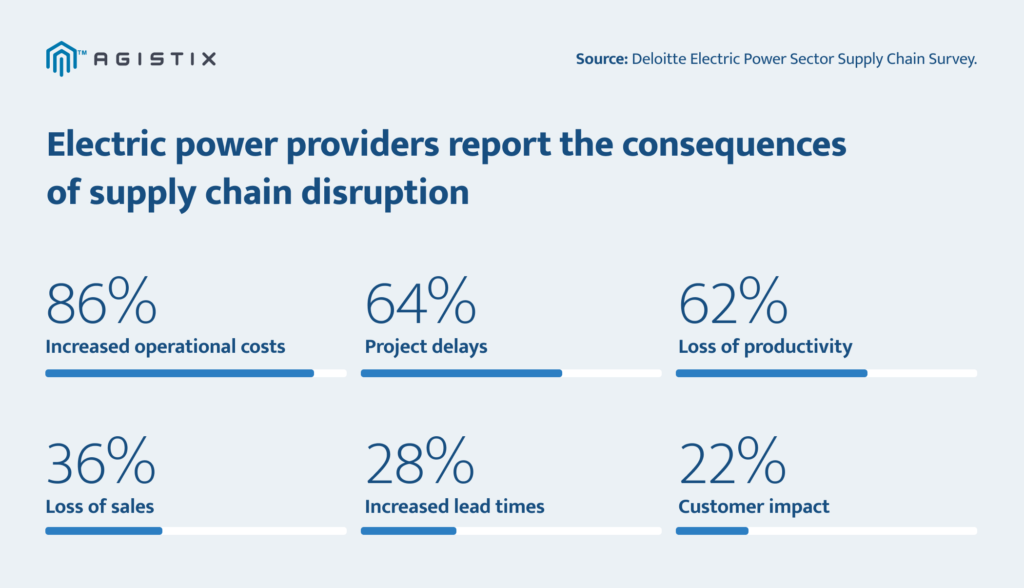January 22, 2025 - 6 minutes read

How Supply Chain Visibility Helps Energy and Utilities Companies Navigate Complexity
In the energy and utilities sector, every delay, disruption, or bottleneck creates a ripple effect, impacting the lives of millions who rely on essential services. The industry is also undergoing a transitional period—driven mainly by the shift towards cleaner energy sources—which presents numerous operational challenges. Whether these challenges present a serious threat or not depends on a business’s ability to be transparent, resilient, and collaborative.
In the midst of this transition, businesses face a growing need to upgrade infrastructure, adopt new technologies, and reevaluate traditional supply chain processes. Effective utility supply chain management strategies are essential to navigating these demands. They provide the framework to address supply chain complexities, stabilize operations, and position companies for success in a rapidly changing energy landscape.
The unique challenges of energy and utilities supply chains
Energy and utilities companies operate in a highly regulated setting with complex logistical needs. Transporting specialized equipment, hazardous materials, and essential components demands meticulous planning and coordination, often covering long distances and complicated regulations. The cost of downtime can be astronomical, as disruptions affect millions of customers and infrastructure. According to the Department of Energy, such outages cost the U.S. economy an estimated $150 billion annually, highlighting the need for reliable and efficient supply chain operations.
Here are some key challenges made even more difficult by a lack of visibility:
- Delays in critical infrastructure projects: Sourcing specialized equipment for grid modernization and renewable energy projects often comes with long lead times—including transformers, which can take up to 52 weeks. Without visibility into procurement, it is nearly impossible to track orders, anticipate delays, and manage expectations, which throws timelines off and drives up costs.
- Asset mismanagement: Utility companies oversee extensive assets like transformers, pipelines, and power equipment across multiple regions. Limited visibility into asset location, condition, and maintenance history leads to costly repairs, poorly planned maintenance, and increased safety risks.
- Supply disruptions: Natural disasters, geopolitical events, and unexpected failures frequently disrupt supply chains. Events like the COVID-19 pandemic and the Ukraine crisis have highlighted the fragility of global supply chains, threatening the flow of essential materials and components.
Without real-time visibility into potential disruptions, companies may struggle to respond effectively.
The role of visibility technology in energy and utilities supply chains
Visibility technology gives energy and utility companies a powerful tool to oversee supply chain operations in real time—track goods as they move, monitor stakeholders, manage assets, and analyze performance data.

Compliance with safety, environmental, and data security regulations is essential, and visibility tools enable companies to document their compliance efforts. Operational efficiency is equally vital. Visibility platforms help optimize logistics, reduce waste, and accelerate processes, providing the data and insights necessary to identify inefficiencies and enhance resource allocation.
Benefits of supply chain visibility for energy and utilities
When energy and utility companies gain a clear and real-time view of their operations, they open the door to a wide range of benefits that touch every aspect of their business:
- Risk mitigation and proactive issue resolution: Real-time insights help identify and address potential disruptions early, reducing costly outages and ensuring smoother operations. For example, monitoring weather patterns can guide proactive maintenance to protect power lines during storms.
- Regulatory compliance: Clear visibility provides accurate, auditable data to meet strict safety, environmental, and reporting requirements. This transparency ensures compliance, avoids penalties, and supports ESG initiatives.
- Optimized asset management: Visibility tools enable real-time tracking of transformers, generators, and pipelines, improving utilization and anticipating maintenance needs to prevent unexpected failures.
- Cost control: A complete view of procurement processes helps identify savings opportunities, negotiate better supplier rates, and improve sourcing strategies.
- Supplier accountability: Visibility into supplier performance and delivery times enhances accountability and collaboration, reducing risks and creating a more resilient supply network.
- Data-driven decisions: Access to actionable insights allows for informed, strategic decision-making, reducing reliance on guesswork.
- Environmental sustainability: Visibility supports cleaner energy transitions by tracking emissions, optimizing transport routes, and encouraging responsible resource use.
- Resilient infrastructure: Real-time monitoring ensures targeted maintenance and minimizes failures, improving the reliability of essential services like electricity and water.
- Digital transformation and Industry 4.0: Visibility solutions drive innovation through smart grids, digital twins, and proactive maintenance, setting the foundation for a sustainable, efficient future.
- Customer confidence: Reliable visibility enables consistent service delivery and proactive communication, keeping customers informed and satisfied.
The benefits of investing in comprehensive visibility solutions are obvious: enhanced operational efficiency, improved decision-making, and a stronger foundation for resilience and sustainability. However, gaining these advantages depends heavily on choosing the right visibility technology.
Selecting the right visibility technology for energy and utilities
Reliability and efficiency are crucial in the energy and utilities sector, so selecting the right visibility technology is a critical decision for improving operations and profitability. To help you navigate this process, here are the features and considerations to keep in mind:
1. Comprehensive visibility across all modes and shipment types
- Multi-modal support: The solution should provide visibility across all modes of transportation relevant to your operations, including rail, truckload, LTL, parcel, ocean, and air freight.
- Diverse shipment types: Ensure the platform can handle various shipment types, including inbound shipments of raw materials and components and outbound shipments of finished goods, as well as third-party and intra-company shipments.
2. Robust data integration and management
- Legacy system integration: Integration with existing ERP, WMS, and TMS systems is essential for minimizing data silos and gaining a unified view of supply chain operations.
- Diverse data sources: The platform should be able to collect and normalize data from various sources, including GPS trackers, RFID tags, carrier APIs, and other third-party systems.
- Data ownership and control: Maintain complete control over your supply chain data, with the ability to define access permissions, ensure data security, and comply with regulatory requirements.
3. Advanced analytics and reporting
- Real-time tracking: Get instant updates about shipment location, status, and potential delays to proactively address issues.
- Performance analysis: Track key performance indicators (KPIs) like on-time delivery, freight costs, and carrier performance to identify areas for improvement and measure the impact of your initiatives.
4. Scalability and adaptability
- Scalable architecture: The solution should be scalable to accommodate growth and changes in operations, adapting to the evolving demands of the energy and utility sector.
- Flexible integrations: Ensure the platform can easily integrate with new technologies and data sources as your needs evolve.
5. Compliance and security
- Regulatory compliance: The platform should support compliance with industry-specific regulations and standards, such as those related to safety, environmental protection, and data privacy.
- Data security: Robust security measures, including encryption and access controls, are essential for protecting sensitive supply chain data.
Investing in a comprehensive visibility solution allows energy and utility companies to gain the control and insights needed to build more sustainable, resilient supply networks.
Optimize your energy and utility supply chain with Agistix
Supply chain visibility is a powerful instrument for energy and utility companies, enabling them to tackle unique industry challenges while providing reliable service to customers. With a full understanding of their operations, these companies can continue delivering essential services while effectively minimizing disruptions and outages. This visibility also allows for proactive communication with customers regarding planned maintenance, potential outages, and estimated restoration times, fostering a sense of trust and transparency.
Schedule a demo of the Agistix platform today to see how our visibility, execution, and collaboration tools can transform your supply chain and logistics operations.

